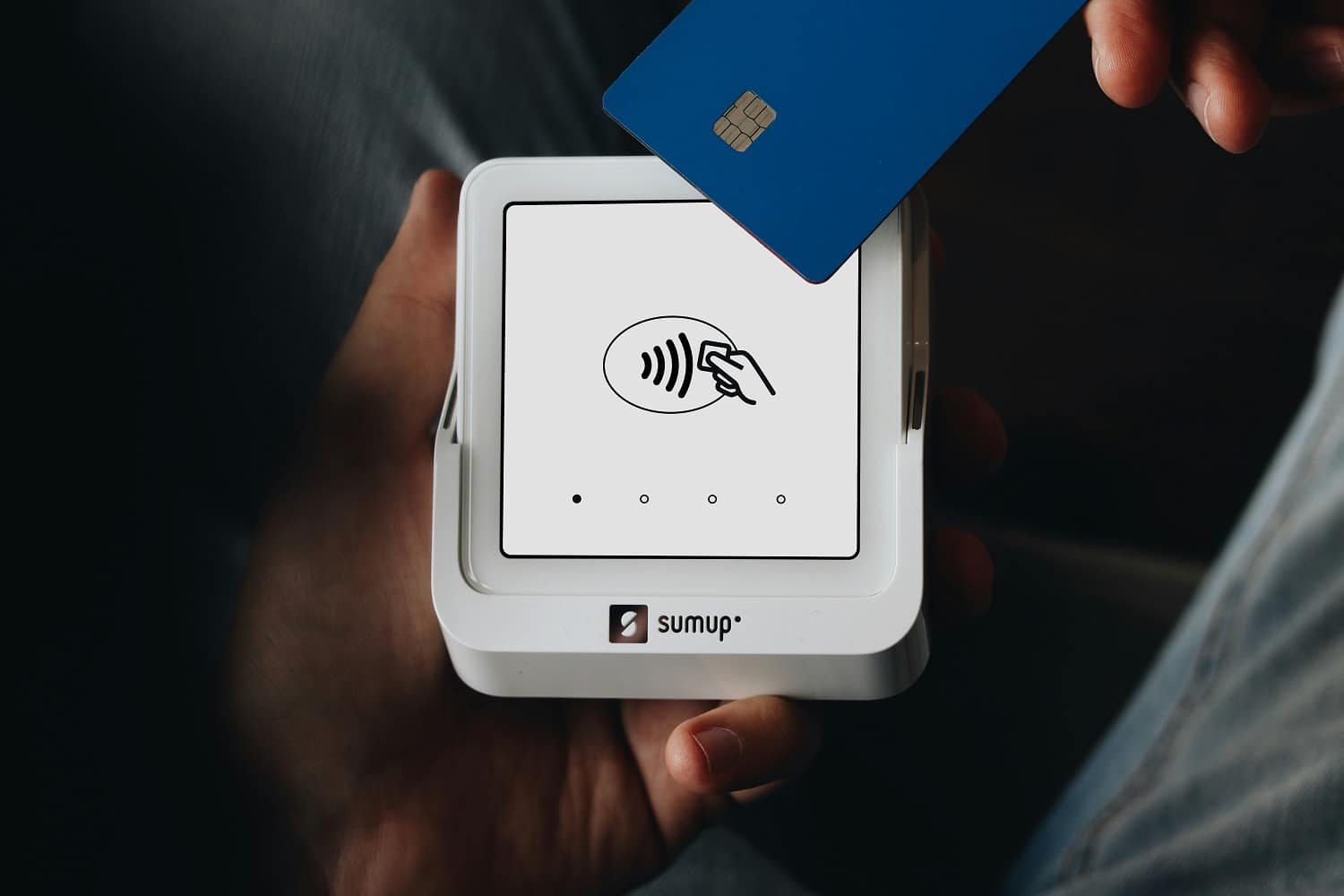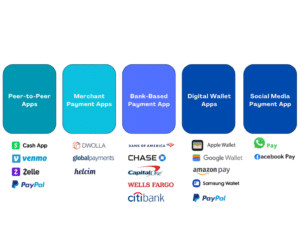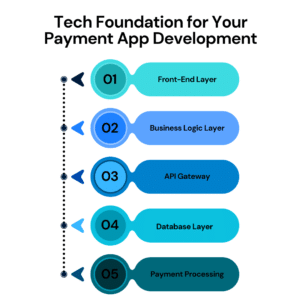The global market for digital payments is estimated to surpass the mark of $361.30 billion by the year 2030, with an annual growth rate of 21.4%. To give you an even better perspective, more than 89% of Americans are already using digital modes of payment to live a cashless life, which is now a very evident trend.
However, as the user demand grows, the existing payment apps are falling behind due to slow money transfers, hidden fees, outdated UI, and several other reasons. Due to this, there is a very vivid gap in this sector, full of opportunities for businesses to thrive. Building a payment app that can establish speed, security, and user-friendliness can help a business fill this gap and meet the users’ demands proactively.
Now that you understand the market demand and are all set to embark on your own payment app development project, knowing the process is equally important for making the final decision. This guide will help you learn about the important aspects involved in building a successful mobile payment app. Read along till the end, before you outsource your project to the best app development company.
Definition and Types of Payment Apps
Before giving you a step-by-step guide on how to create a payment app, it is important that you are clear about the options at hand. Therefore, here is a brief overview of what payment apps are and their varying types.
Definition:
In simple words, a payment app is a mobile software with the capability of helping users transfer funds with peers, entities, or businesses electronically. The primary purpose of any payment app is to encourage cashless transactions that empower efficiency and convenience over traditional payment methods.
Types of Payment Apps:
There are basically four different types of payment apps for you to count on, which include:
1. Peer-to-Peer Apps
Peer-to-Peer payment apps are meant to enable users to send or receive money digitally, using their respective smartphones. When you build a P2P payment app, you are allowing individuals to make money transfers without the need for any middlemen, such as banks or payment processors. Such applications offer users a faster and more convenient way to make quick payments.
Examples: Venmo, Cash App, Zelle, and PayPal
2. Merchant Payment Apps
When you visit a merchant store and provide them with your credit/debit card for paying the invoice or bill amount, they will be using dedicated apps on their devices for processing that payment. The software they use is called the merchant payment apps! For instance, in Apple Retail stores, a customer representative will use an iPhone with an integrated merchant payment app to charge your card for the purchase made. Such apps are already integrated with the payment gateways for seamlessly transferring the funds from customers’ credit/debit card accounts to the merchant’s bank account.
Examples: Dwolla, Global Payments, and Helcim
3. Bank-Based Payment App
The bank-based payment apps are developed by traditional banks and neobanks to allow customers to transact with the bank. Such apps implement the usual banking infrastructure on digital accessibility, powered with a payment gateway and a transaction processing system. These features enable users to process or settle financial transactions through the app in fiat currencies.
Examples: Bank of America, Chase, Capital One, Wells Fargo, Citibank, etc.
4. Digital Wallet Apps
Such payment apps have integrated digital wallets that are built for specific mobile OS, such as Android, iOS, or both, supporting QR-enabled or NFC-based payments. Mobile device manufacturers often tailor their own version of payment apps to provide their users with the flexibility of making cashless transactions.
Examples: Apple Wallet, Google Wallet, Amazon Pay, Samsung Pay, PayPal Digital Wallet, etc.
5. Social Media Payment App
Social media companies often introduce their own version of payment apps, embedded in their platforms. The purpose of such apps is to enable users to make peer-to-peer payments easily, without the need for using any other third-party apps. For instance, apps like WhatsApp, Facebook, Snapchat, and others have integrated a P2P payment feature.
What Features Can You Consider in a Payment App?
Now that you have a clear overview of how payment apps are categorized differently based on their purpose or usability, it is time to shed some light on the features you can consider to include while developing one:
1. Account Linking:
A payment app must enable users to link their credit cards, debit cards, or bank accounts securely for easy processing of financial transactions. This process involves the integration of the API with the financial institutions through real-time verifications. Existing apps like Venmo, Cash App, or PayPal enable users with this convenient feature and have set the standard for newcomers in the industry.
2. Money Movement:
The core value proposition of any payment app is to move money from one account to another. Users must have the flexibility of seamlessly sending, receiving, or requesting money through your payment app. As part of this feature, you must also enable functions like transaction confirmations, payment history, and accessibility.
3. User Authentication:
Phone verification, password creation, profile setup, and other such steps must be integrated alongside your payment app development process. These features will establish a proper user authentication process for your app, establishing robust security. Modern-day payment apps can also be built with the feasibility of biometric authentication, as users are increasingly relying on it today.
4. QR Code Payments:
QR payments are among the recent trends encouraging contactless transactions all across the globe. This feature enables users to scan the QR codes for paying digitally at any physical or retail location. Due to this feature, your app will be beneficial beyond just peer-to-peer or bank transfers. Apps like Square, Venmo, and PayPal support QR code payments.
5. Smart Chatbots:
With new-age digital payment features, there comes an additional need for support among users. Therefore, integrating smart chatbots into your mobile payment application will make it easier for you to tackle common or even some complex issues of users. Every person using a digital payment app will need instant help because there’s money involved.
6. Bill Payment Integration:
Beyond simple retail or peer-to-peer payments, make your app exclusive by adding a bill payment feature to it. Integrate a specific module into your payment app that can enable users to pay rent, utilities, and other such recurring expenses. This way, you can encourage prolonged engagement among users towards your app.
7. Merchant Payment Services:
To scale your business exponentially, target not just the end-users but also the merchants or retail businesses. Offer merchants the opportunity to enroll with your brand to accept customer payments through your platform. Alongside that, you can offer them additional features such as inventory management, PoS integration, and sales analytics.
8. Investment:
Allow users to plan, execute, and track their investments on your digital payment platform to attract the attention of a special class of audience. Investment features like buying cryptocurrencies, bonds, or stocks with easy payments through linked bank accounts can help you transform your simple app into a comprehensive financial hub.
9. International Transfers:
Take your payment app one notch higher by enabling it with support for international transfers. With this, you will be welcoming a global audience to be your app users and can facilitate them to seamlessly transfer or accept payments without geographical or currency boundaries. As part of the planning process, consider how users evaluate the best international money transfer method so your app can offer a more competitive and user-friendly experience. Enabling this feature will require you to comply with international regulations and also enable currency conversion functionality.
10. Budgeting Tools:
Alongside practical payment functionalities, you can also provide your users with budgeting tools embedded within the app. It will allow them to track their spending patterns and set financial milestones. By adding this feature, you will be distinguishing your digital payment platform from those of the usual money transfer apps.
Technical Foundation You Must Establish for Payment App Development
In the quest to know how to create a payment app, you need to have a tech foundation established with strategic choices. It will help you emphasize your app towards long-term maintainability, data integrity, and regulatory compliance. All the modern-day payment or banking platforms prefer to adopt a layered and structured tech architecture for curating their dedicated apps. So, to help you start off with the right foot forward, here are a few technical aspects you need to consider for developing a payment app:
1. Front-End Layer
The first technical aspect of building a payment platform is the front-end! It is the user-facing side of your mobile application that must prioritize accessibility, seamless API integrations, and performance.
For streamlining the overall payment app engineering process, developers are recommended to use cross-platform technologies such as Flutter and React Native. Due to this, you can attain the flexibility of maintaining only a single codebase for both Android and iOS versions of your app.
Such technologies are meant to integrate consistent UI/UX and rapid iteration across all the mobile devices on which your app is accessed. If you are inclined towards native app development, it should be considered only if you are leveraging platform-specific features such as biometric authentication on Android or Apple Pay integration.
2. Business Logic Layer
The next most important tech aspect in your app development journey will be the business logic layer. In the process, your developers must adopt a microservices architecture for breaking the app into independent and modular components such as notifications, payments, and user management.
The purpose of this segmentation is to develop, launch, and scale each of those components separately, which will eventually improve the overall system resilience. It means failure in any of the one services won’t directly or instantly impact others.
Thus, the development team can work concurrently on different components, all at the same time, which will eventually speed up the overall process and facilitate quick deployment.
3. API Gateway
When seeking mobile payment app development, the API gateway will act as the unified entry point for all the client-server interactions. It is the technology that will handle all crucial middleware responsibilities such as request validation, logging, authentication, and rate limiting. Thus, the overall load on downstream services will be lowered!
An API gateway also embeds strong security policies to ensure that all the payment requests are thoroughly authenticated and directed towards adequate backend services. Express.js and Node.js are the two frameworks ideal for establishing an API gateway, considering they are lightweight and robust for encouraging rapid flexibility and development.
The above frameworks are ideal only if you have moderate scalability or technical priorities. On the other hand, if your payment app development project demands high reliability or enterprise-grade scalability, you can leverage the potential of Spring Boot with Java as an alternative choice.
4. Database Layer
In your digital payment platform, the database layer holds utmost responsibility for the storage & retrieval of all structured data that is crucial for the app’s operations. Data such as audit logs, transaction records, and user profiles are stored & accessed within the database layer.
PostgreSQL is one of the most commonly recommended database layers for payment app development, mostly because it offers robust support for advanced querying, schema enforcement, and ACID-compliant transactions.
In order to make your app handle real-time data accessibility and facilitate temporary storage needs, your developers must use Redis. This fastest vector database can be used for session management, rate-limiting sessions, and caching.
Redis also has an in-memory data structure that can support low-latency access to all the commonly requested information, which will enhance the overall app responsiveness.
5. Payment Processing
You can either create a custom payment infrastructure for your app or integrate it with the external providers such as Square, Adyen, or Stripe. For creating a custom infrastructure, you will need to deal with several technical and regulatory requirements, backed by engineering proficiency.
On the other hand, integrating your app with the external payment providers will get you built-in support to facilitate transaction handling, compliance with PCI DSS standards, fraud detection, and secured financial transactions.
Step-by-Step Process on How to Create a Payment App
Now that you know the technological foundation you need for curating a highly functional payment platform, here are the clear steps you need to adopt, right from ideation to deployment:
1. Define Business Objectives and Identify Target Audience
Before starting out with your app development project, you need to outline the idea and purpose of it. Following that, you need to specify your target audience, which will eventually help you decide on the practical features you need for your payment app. For instance, you can determine if you want your app to encourage in-store mobile transactions, online purchases, or peer-to-peer transactions.
Not just that, you can also conduct various surveys to determine the pain points or preferences of your target audience. For instance, you can collect insights into whether your audience demands international payments, multi-currency support, investment perks, or other such features. Focus your development approach based on the data you collect in this stage.
2. Conduct a Thorough Market Analysis
Take the help of your payment app development company and understand the trends ruling the market. Through a proper analysis, you can determine how your app would align with the needs of your users. In the process, you can review competitor apps and assess customer expectations. Filter the unique selling points crucial for making a payment app successful, followed by any potential gaps that you can address through your platform.
For instance, prior to building a payment mobile application, you must research the popular options that exist, such as Cash App, PayPal, Apple Pay, Google Pay, and others. This way, you will understand why a specific group of users prefers one app over the others, and implement the same for your product. Not just that, but proper market research can also help you identify key digital payment trends like BNPL (Buy Now Pay Later) service, contactless payments, and crypto integration.
3. Define App Features & Requirements
In this step, you must make a list of all the features or functionalities that you need in your payment application. This guide has already talked about some of the most common and advanced features you can count on! Refer to them, or express your custom expectations specific to your brand product, for developers to plan, build, and integrate them.
Features like contactless payments, social payments, biometric user authentication, investment, multi-currency support, smart chatbot integration, and others are highly in demand. Partner with one of the best payment app development companies with skilled developers for prioritizing your custom feature requests.
4. Decide on the Development Approach
You must know that developing a FinTech software demands a complex approach with robust technical expertise. Therefore, you get to opt for one of the two development approaches for addressing your payment app development project.
You can either build your software from scratch with complete customization and control over the process of development. This way, you will have the scope of flexibility to make adjustments as per your business requirements. However, this entire process can be time-consuming and expensive because of the resources required.
On the contrary, you can also pick a ready-made payment software to reduce the overall time and cost of development. There are several vendors that offer white-label payment apps for you to brand and use. Experts can help you make customizations and scale it effectively to meet your business needs.
5. Seek a User-Friendly Interface Design
Intuitive navigation, efficient onboarding, personalization, and customization are a few efficient design efficiencies that you must integrate into your payment app. Providing your users with the flexibility of navigating and using the payment features without a complex understanding is paramount.
When you implement intuitive navigation, you will be providing users with a straightforward process, making it easy for them to access the app. Initiating transactions or adding payment methods must be seamless for the users. Beyond that, seamless onboarding will help guide users to quickly set up their profiles and link their bank accounts to start making digital payments on your app.
Your team of developers must prioritize UI/UX design to ensure every common or advanced feature is accessible with simple steps, catering to different audience groups. Considering that, the app design should also be compliant with WCAG 2.1 AA accessibility standards, ensuring that your platform will be accessible for people with disabilities.
6. Development
Engineers will be starting off with front-end and back-end development of your payment app, followed by database implementation. Following that, they will also be integrating the important third-party systems such as KYC/AML services, budgeting tools, fraud detection features, payment gateways, and others. Every line of code being written must prioritize stability, compliance, and security as financial data holds critical sensitivity.
While approaching payment mobile app development, the backend architecture must be curated for handling 10 times the projected load. Thus, it will ensure long-term scalability of your app!
7. Build an MVP (Minimum Viable Product)
Your payment app development team will then be building an MVP for collecting users’ input and evaluating the integrated features. The MVP of your payment app will have all the basic features as per your project plan, giving you the chance at identifying any problems, validating presumptions, and testing user-centric features. All the potential bugs, errors, or inefficiencies in the payment app can be fixed early on, before the final version of it can be deployed.
8. Testing & QA
In continuation with the insights collected and acted upon with reference to the MVP of your payment app, the final version still needs to be tested on various case fronts. For instance, your app can be tested to ensure consistent performance across all devices, platforms, or usage patterns.
The QA team will be running certain test cases alongside the development process to detect and fix potential flaws early on. You can also encourage the establishment of an automated testing pipeline before developers write the production code, to make the overall process easier.
Code reviews, vulnerability scanning, load testing, functionality testing, and other such QA instances will also be executed before the app can be considered ready for deployment.
9. Launch Your Payment App and Seek Post-Launch Support
You can then launch your payment mobile application to the App Store or Play Store by adhering to their specific guidelines. The professionals you hire for handling your project will be mindful of the App Store or Play Store guidelines right from the first step of the process, making it easier to pass the review process of these platforms.
You must also make sure to timely update or upgrade your app to ensure it stays secure, relevant, and competitive. Act upon the users’ feedback and market trends to expand the functionality of your app, and keep it more user-centric over time.
Let Simpalm Help You With Comprehensive Payment App Development Solutions!
Simpalm is the best mobile app development company in USA, with diverse expertise in creating robust solutions for different industries. Payment app development is one of our many comprehensive solutions for businesses to deliver a profound user experience to their audience. We have a dedicated team of developers with proficient knowledge of utilizing the latest technologies and integrating top-end features for curating your payment platform.
At Simpalm, we believe that stepping into the payment app landscape with your own platform needs something more than just robust coding skills. You need a strong team of professionals that understands not just the technical supremacy your project needs, but also the business realities that the industry poses.
So far, we have helped hundreds of companies build a digital version of their business idea, guaranteeing intuitive UI, high-performance features, and improved user experience. From ideation and competitor analysis to development and post-launch maintenance, we make sure you drive success with your initiative.
We combine appealing front-end, solid backend architecture, and advanced features to tailor the perfect payment platform, specific to your target audience and business preferences. So, if you want an ultimate partner to help you develop a mobile application that can support financial transactions, budgeting, investments, international money transfers, and more, reach out to us today!

 App Development
App Development Web Engineering
Web Engineering AI Services
AI Services Startups
Startups Health / Fitness
Health / Fitness Education
Education Social
Social Nonprofit
Nonprofit Fintech
Fintech Logistics
Logistics Government
Government HR Software
HR Software About Simpalm
About Simpalm Our News
Our News Client Testimonials
Client Testimonials Careers
Careers Awards
Awards Resources
Resources Information
Information




